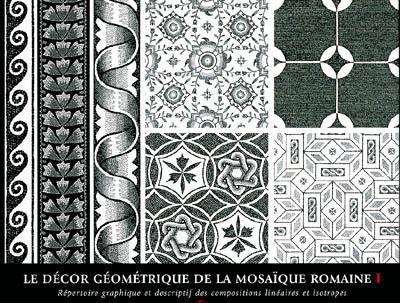
Fiche technique
Format : Relié
Nb de pages : 431 pages
Poids : 2334 g
Dimensions : 29cm X 24cm
EAN : 9782708406247
Répertoire graphique et descriptif des compositions linéaires et isotropes
Quatrième de couverture
Ce recueil de plus de 1 600 dessins à la plume, dus au talent de Richard Prudhomme, est d'abord une œuvre graphique exceptionnelle, hommage d'un artiste contemporain au génie décoratif des mosaïstes de l'Antiquité. Il est aussi une source d'inspiration inépuisable pour les graphistes de notre temps.
Il s'agit d'une œuvre d'archéologie scientifique, fruit du travail collectif, au CNRS, du Centre de Recherche sur la Mosaïque fondé par Henri Stern.
Les centaines de motifs géométriques répertoriés couvrent l'ensemble du champ méditerranéen et de la civilisation romaine, depuis ses origines hellénistiques jusqu'à ses prolongements protobyzantins, et forment un catalogue quasi exhaustif des inventions ornementales de la mosaïque antique en matière de compositions linéaires et isotropes.
C'est enfin un travail méthodologique et linguistique de première importance. Chacun des dessins est accompagné d'une description normalisée en français, allemand, anglais, espagnol et italien, le français, langue dans laquelle ont été conçues les descriptions, jouant le rôle de langue de référence.
Cet ouvrage propose ainsi la constitution d'un vocabulaire descriptif, élaboré à l'échelle internationale ; il facilitera les publications ultérieures et l'échange des informations dans ce domaine, fournissant un moyen de communication univoque pour aborder l'étude d'un des plus riches systèmes ornementaux qui aient jamais été conçus.
Ce recueil, précédé d'une préface bilingue (anglais-français) comporte un lexique et 254 planches de dessins accompagnés de leur description en cinq langues et d'une référence bibliographique pour chacun des pavements reproduits. Un index français renvoie aux planches ; pour les autres langues, un index des termes choisis renvoie aux entrées correspondantes de l'index français.
La présente réédition rencontre l'attente d'un public qui réclamait un ouvrage épuisé depuis plusieurs années.
This collection of more than 1,600 pen-and-ink drawings, created by the talented Richard Prudhomme, is above all an outstanding graphic work - a tribute by a contemporary artist to the decorative genius of ancient mosaicists. It is at the same time an inexhaustible source of inspiration for today's graphic artists.
This is a scientific archaeological work, the result of a collective enterprise carried out at the CRNS by the Center for Mosaic Research founded by Henri Stern.
The hundreds of geometric motifs assembled here cover the entire Mediterranean zone and Roman civilization, from its Hellenistic origins to its later continuation in Early Byzantine times. They form a well-nigh exhaustive catalogue of the ornamental inventions of ancient mosaics, regarding both linear and isotropic patterns.
Lastly, this volume is a very important methodological and linguistic study. Each design is accompanied by a standardized description in French, German, English, Spanish and Italian, with French serving as the language of reference, since the descriptions were orignally written in that language.
This present work thus offers a descriptive vocabulary of international significance and scope. It will facilitate future publications and exchange of information in this field, providing an unequivocal means of communication for the study of one of the richest ornamental systems ever created.
This book, which begins with a bilingual preface (French-English), contains a lexicon and 254 plates of drawings accompanied by their description in five languages and a bibliographical reference for each of the pavements illustrated. A French index refers directly to the plates ; an index of selected terms in each of the other languages refers to the corresponding entries in the French index.
This new edition aims to satisfy the public's request for a work that has been out of print for several years.





